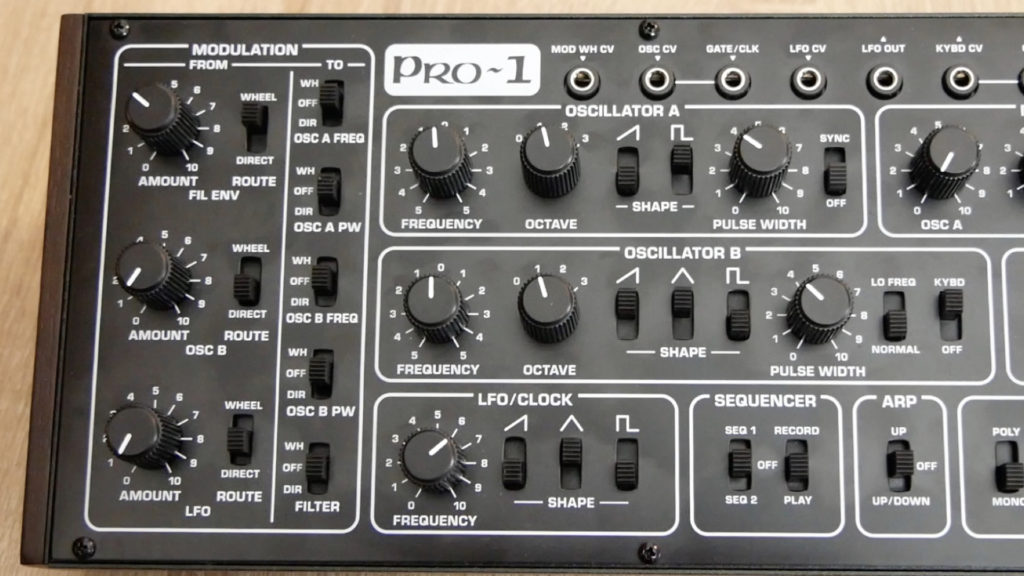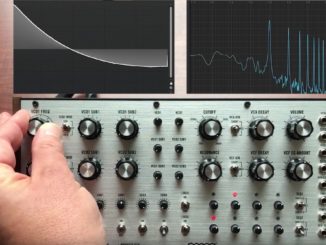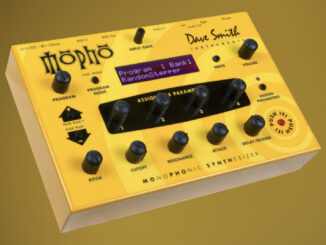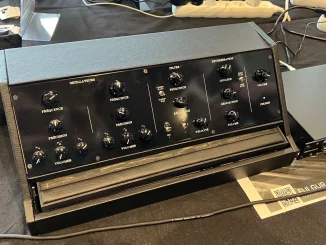Review: With the Pro-1, Behringer shows an almost perfect Sequential Circuits Pro-One replica with patch points for the Eurorack format for an unbeatable low price.
There are countless clones of the Moog Minimoog or the Roland TB-303 analog bassline Synthesizer. Pro-One replicas, for example, almost none. Dave Smith, the developer of the Pro-One recently released with the Toraiz sub-brand of Pioneer DJ the AS-1, a modern version of it. Unfortunately, it was not a great success. However, when Behringer announced a replica of the Pro-One for the Eurorack format and at a very affordable price, there was much more interest.
It is now available for a very affordable € 329 and has been tested for the past few weeks. Big thanks for making this “fearless” Behringer Pro-1 review possible by your purchases over the partner links on Synth Anatomy. Now everything from the beginning: The Pro-1 is an analog semi-modular synth based on the original circuit designs of the Sequential Circuits Pro-1. Without a keyboard, unfortunately, but adapted for the Eurorack format.
Layout & Build Quality
Visually, the synth is extremely reminiscent of the original layout, even the colors (black, white) and knobs are similar. The Pro-1 feels valuable and knobs have a very nice grip. In my opinion, the best grip, I’ve ever seen on a Behringer Synthesizer so far. On the other hand, I must criticize the switches, which are not so great for me, which feel a bit hollow and cheap. But you also have to know that the original Sequential Circuits Pro-1 was not a device that shone with high quality.
These switches are acceptable for the requested price of 329€. However, I would have expected the developers to do it a little better, especially because these contribute a lot to the feel of the Pro-1. Also, the bases or sockets on my device are unfortunately not properly processed, so it always wobbles something if you use the device. But you can fix this easily. On the whole, the optical processing quality is not perfect in my opinion but good enough. We are still talking about a budget synth and not a premium boutique product.
The side parts are unfortunately not made of wood but are imitations made of plastic. It doesn’t feel great but you can live with it.
MIDI In & Back Side
Behringer remains true to itself. The Pro-1 also has a MIDI input on the front panel. I’m not a friend of it myself, I prefer it on the back. Here, you can find an audio output, dip switches for midi routing, a MIDI output/thru, USB connection (not for audio) and a power connection with an ON/OFF switch. The USB can only transmit MIDI notes, mod wheel movements, the LFO, and the sequencer MIDI notes. No MIDI CC or velocity over USB is possible, too bad.
Analog Engine
Like the original, the Behringer Pro-1 features two oscillators with various waveforms based on the 3340 chips. VCO A offers saw and pulse, VCO B sawtooth, triangle and pulse which can be used all in the same time. Both VCO blocks also include pulse with modulation (PWM). In the mixer section, you can also mix an additional noise generator to the sound. Since you can also use these at the same time, this allows you to create these very powerful and fat sound of the Pro-1.
Of course, the legendary sync function of the oscillator A Block was also adopted and reproduced. With this, you can get the well-known and lovely sync sounds of the Pro-1. And yes, the Behringer Pro-1 makes them as hot and lovely as the original Pro-One from Sequential Circuits. The signal then goes into a 24dB lowpass filter which can score above all because of its beautiful resonance. The filter can also be modulated with a complete ADSR envelope and by the built-in LFO.
Thanks to the semi-modular conversion, it is now also possible to modulate the resonance and use it more versatile. You can also go to extremes with the modulation and the filter. This shows my video review on the Synth Anatomy YouTube channel.
The Modulation Matrix, What Makes The Pro-1 So Unique
A Pro-One replica is not one without the legendary modulation matrix on the left side. Also here, all modulation paths are controlled on the left side by a reproduction of this unique hardware mod matrix. In retrospect, this was revolutionary in the first Pro-One, because it gives you a very smart way to change mod routings. But okay, in today world, however, less newish. Today we have huge digital modulation systems with many sources and destinations.
The modulation matrix in the Pro-1 has three mod sources: filter envelope, oscillator B which can be used as second LFO and the primary LFO. with individual amount knobs. Clever here is that you can these fixed mod destinations can be broken out of the standard routings. These can be used to modulate the oscillator A or B frequency or pulse width (result PWM) or the filter cutoff. Since you have the other outputs in the Eurorack compatible patch bay, you can also route them to the resonance or other destinations. Plus, you can choose whether you use direct or mod wheel control. Especially this mod matrix makes the Pro-1 more versatile and complex than a Model D per example.
Modulation Sources: Digital Envelopes
There are also two envelopes, one for the filter and one for the VCA. As you have seen, this fixed connection can be broken with the mod matrix or with the patch bay on the top of the synth. It is interesting to note that there are no analog envelopes installed here, but digital ones. The original (Sequential Circuits Pro-One) used the Circuits CEM3310 chip, which Behringer/Cool Audio has not yet cloned.
According to other media (Amazona.de…), these are emulated and controlled by an ARM processor. There are clear signs of this on the Pro-1 board. If these are really emulations, then they have been implemented very well. They react like the original. They are very short and nice for percussive sounds. In my unit, I noticed that the sweet spot on the envelopes is not 100% perfect. Often little or a lot of happens. I can not test whether this was also in the original Pro-1.
Further, there is one LFO with sawtooth, tri and pulse waveforms. If one LFO is not enough, the second oscillator can also be used as a second LFO, which makes the Pro-1 very versatile.
Easy But Effective Sequencer
A reproduction of the original Pro-One sequencer is also onboard which offers two sequences but expanded to 64 notes. You can also add rest in the sequencer by turning the record switch down and up. Further, there is an arpeggiator onboard with up and up/down direction installed. Like on the original, the LFO also works here as a clock for the sequencer and arpeggiator. Nice little sequencer, where there is nothing to criticize.
Utilities
In the area below there are further setting options like several trigger modes like a drone mode perfect for drone sounds. In the mono/poly mode, you can decide whether you want to play it in monophonic or paraphonic. But don’t forget, there is also a poly chain feature with where you can add up to 16 pro-1 and built a Behringer Pro16. Plus, it comes with a glide function that offers two modes: one normal mode where each note glides or an auto mode where legato played notes glides.
Semi-Modular, Connect Me With Cablese And The Outside World
One of the most important changes on the Pro-1 from Behringer is the possibility to integrate it into a Euroack system by either taking it out of the case and using it as a synth voice module or patching it directly from the housing. For this, it offers CV and trigger inputs/outputs and audio I/O.
- CV inputs: mod wheel CV, oscillator CV, gate/clock trigger, LFO CV, cutoff CV, and resonance CV
- CV outputs: LFO out, keyboard CV out, gate trigger, filter envelope CV, amp envelope CV
- audio inputs: external input
- audio outputs: mono audio out, phones out (pseudo stereo), and mixer out
The external audio input is really nice because you can route other sounds in the Pro-1 and shape them with the Pro-1 filter. It would have been even better if there had been another external entrance with a large jack on the backside. You can use this input to route in audio triggers. The new patch points are nice extensions that make the Pro-1 much more interesting and versatile. When patching, I noticed that the socked is not so perfectly processed, patch cables have to be inserted a little more firmly.
Behringer Pro-1 Review: Final Verdict
In summary, Behringer did an almost perfect job with the Pro-1. It sounds beefy and comes extremely close to the original unit. From powerful bass/leads to crazy sounds, thanks to the modulation matrix, these are also possible with this new Pro-One clone. Even if the processing is not so perfect at certain points and the MIDI implementation is very limited, I go as far as describing the Pro-1 as the best Behringer clone so far (my opinion). The knobs also give the impression that you are playing with the original.
The expandability through the Eurorack format and patch points is also positive, which makes the Synthesizer more versatile than the original. Nice job Behringer. However, I always have the remaining skepticism about how long they will be in use. Since they want to offer the devices as cheaply as possible, they also have to save in certain areas. Long-term tests will show whether the built-in electronics have been made for many years or not. That is probably one of the most exciting questions at Behringer Synthesizers right now. Can you still use them in 5 or 10 years or have they been electronic waste for a long time? We will see it in the future.
But at the moment I can say: the Pro-1 is a great Sequential Pro-1 clone and anyone who always wants to have one in the studio without spending a lot of money can look at this clone. Alternatively, there is the Toraiz AS-1 which is also an analog Pro-1 by Pioneer Toraiz made in collaboration with Dave Smith. Check out here the full review.
Positive
- sound quality
- authenticity
- surface feel especially the Pro-One style knobs
- paraphone mode
- Eurorack format
- price (329€)
Neutral
- will they still work in 5-10 years? (long-term tests)
Negative
- limited MIDI implementation
- sliders feel cheap
- not perfect build quality (base on the bottom…)
Behringer Pro-1 Synthesizer is available now for 329€ worldwide.
More information here: Behringer
Available at our partner









Be the first to comment